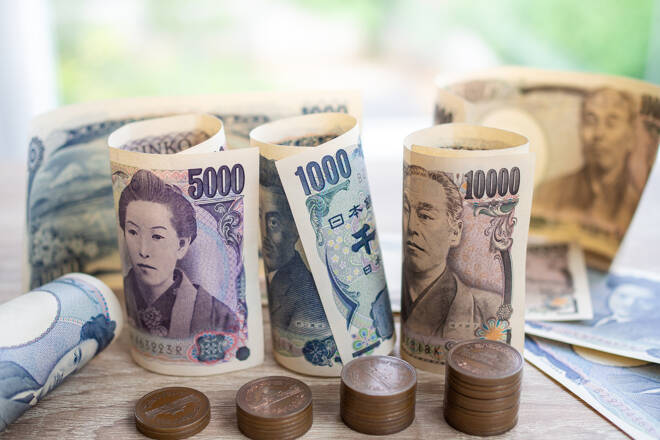Advertisement
Advertisement
USD/JPY Forecast: Yen Intervention Risks and BoJ Rate Hike Signals
By:
Key Points:
- On Wednesday, June 26, the Japanese Yen will likely remain a talking point as the USD/JPY hovers in the intervention zone.
- Crucial economic data releases on Thursday and Friday could alter the USD/JPY trajectory if the Bank of Japan signals a July rate hike.
- Later in the session on Wednesday, US housing sector data and FOMC Member speeches also require consideration.
Intervention Threats May Cap USD/JPY Topside Until Friday
On Wednesday, June 26, the Bank of Japan and the Japanese government will likely influence buyer demand for the USD/JPY.
In April/May, an intervention at 160.209 sent the USD/JPY briefly below the 152 level before a retrace to the 159 handle.
Nevertheless, the USD/JPY failed to break down resistance at 160 this week as investors consider Japanese government threats of an intervention to bolster the Yen.
On Tuesday, Japanese Chief Cabinet Secretary Yoshimasa Hayashi warned about an intervention, saying,
“We are closely watching currency moves and will respond appropriately to excessive volatility.”
Finance Minister Shunichi Suzuki also talked about an intervention, saying,
“We would respond appropriately to excessive currency moves.”
After a gloomy Q1 2024 and disappointing economic indicators from Japan in Q2 2024, the effects of a weaker Yen on the economy will be a focal point.
BoJ Deputy Governor Ryozo Himino recently said,
“Exchange-rate fluctuations affect economic activity in various ways. It also affects inflation in a broad-based and sustained way, beyond the direct impact on import prices.”
While intervention threats may cap the upside, the Bank of Japan may need to take a more hawkish stance to begin restoring buyer demand for the Yen.
Can economic indicators from Japan raise investor bets on a July BoJ rate hike?
Retail Sales and Tokyo Inflation: Crucial Data Releases for the BoJ
On Thursday, June 27, retail sales figures from Japan could influence investor expectations of a July BoJ rate hike. Economists forecast retail sales to increase 2.0% year-on-year in May after a rise of 2.4% in April.
Investors could take better-than-expected numbers as a cue for the BoJ to consider raising rates in July. Upward trends in consumer spending could fuel demand-driven inflation.
However, labor market data and inflation numbers for Tokyo (Fri) could affect sentiment toward the BoJ rate path more.
Economists forecast the Tokyo core annual inflation rate to rise from 1.9% to 2.0% in June. Furthermore, economists expect the annual inflation rate to increase from 2.2% to 2.4%.
Hotter-than-expected numbers and a steady unemployment rate could greenlight a July BoJ rate hike.
The BoJ could justify a market-influencing move by highlighting the effects of the weaker Yen on the Japanese economy.
While economic indicators from Japan will influence the USD/JPY, US data could affect views that interest rate differentials have peaked.
US Housing Market Data and the Fed Rate Path
Investors will turn their attention to US housing sector data later in the Wednesday session.
Analysts predict a 2.9% rise in US new home sales for May, following a 4.7% decline in April. Market participants should be mindful of trends, as new home inventories can cause fluctuations. Rising inventory trends might alleviate price pressures and reduce costs for housing services, including rents. Housing services inflation contributes to headline inflation.
Furthermore, upward trends in new home demand could indicate strong consumer confidence. Increased consumer confidence might boost consumer spending and bolster expectations of a US soft landing.
US Treasury Secretary Janet Yellen addressed Biden administration efforts to provide new affordable housing on Monday, stating,
“We made a few additional announcements today. Things we can do to lower burden in one of our key housing programs of the Magnet Fund and also to help local housing agencies have access to reasonable low-cost financing through the Federal Financing Bank.”
Yellen also mentioned homeowner reluctance to purchase new homes at current mortgage rates, affecting supply-demand dynamics and housing services-related price trends.
Although the housing sector data will attract attention, investors should monitor FOMC member speeches. The next critical data release will be US inflation numbers on Friday.
Hotter-than-expected US inflation numbers on Friday and hawkish Fed chatter could test expectations of a peak to interest rate differentials.
USD/JPY Short-term Forecast
Near-term trends for USD/JPY will hinge on intervention maneuvers, Japanese retail sales, and inflation data. Higher-than-expected figures could greenlight a July BoJ rate hike. Nevertheless, hotter-than-expected US inflation numbers could keep pressure on the Yen.
Rising threats of government interventions and increasing expectations of a BoJ rate hike signal a possible USD/JPY retreat from 159.
USD/JPY Price Action
Daily Chart
The USD/JPY hovered comfortably above the 50-day and 200-day EMAs, affirming the bullish price signals.
A USD/JPY return to 160 and the April 29 high of 160.209 could give the bulls a run at the 161 handle.
Intervention threats and Bank of Japan commentary require investor attention before the US session.
Conversely, a USD/JPY drop below the 158 handle could give the bears a run at the 50-day EMA. A break below the 50-day EMA could signal a fall toward the $151.685 support level.
The 14-day RSI at 68.46 indicates a USD/JPY move to the April 29 high of 160.209 before entering overbought territory.
About the Author
Bob Masonauthor
With over 28 years of experience in the financial industry, Bob has worked with various global rating agencies and multinational banks. Currently he is covering currencies, commodities, alternative asset classes and global equities, focusing mostly on European and Asian markets.
Did you find this article useful?
Latest news and analysis
Advertisement
